Comparing Hoka vs Nike running shoes could largely be described as a difference in fit and feel, along with some company philosophy if you care about those things. Nike has been a dominant player in running shoes for decades. But of course we know that Hoka came on the scene due to their maximal shoes…and that’s interesting all on its own!
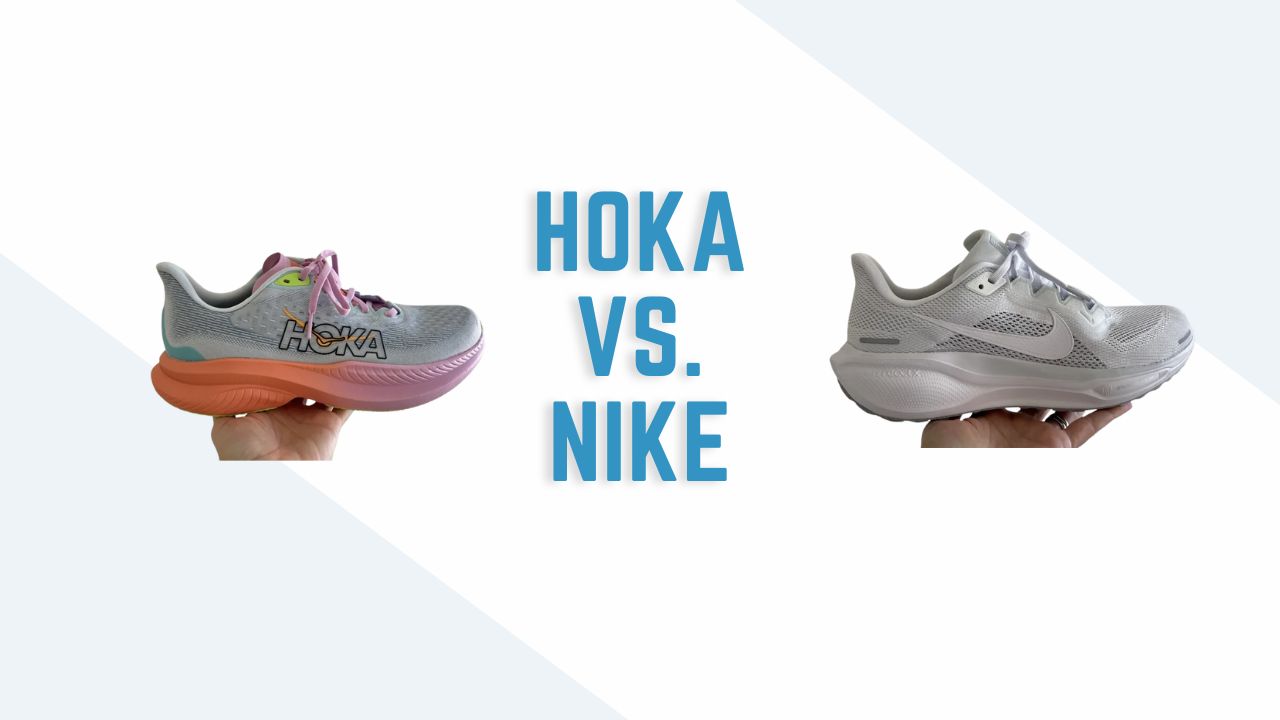
Both brands provide high quality shoes and offer a variety of models to suit different needs like overpronation, cushioning, and trail running.
Hoka One One first became popular with Ultrarunners and has since moved in the to main stream of running. I myself have run in a number of models and previously compared Hoka styles.
Hoka Vs Nike Key Differences
Nike and Hoka offer similar features and models for all kinds of runners, from the new runner to marathon runner to the flat-footed or high-arched.
Largely we’re looking at how a maximal shoes compares to a traditional running shoe. However in this case, I would also say we’re looking at function vs fashion. Because Nike wants to be the cool shoe and HOKA just wants you to run a long ways feeling good.
Nike does offer trail shoes, but I believe Hoka has more for the ultrarunner.
I break down the differences in more detail below, but here’s a quick overview:
Hoka Running Shoes
- Maximal shoe – has the larger sole for stability and smooth ride
- Usually more cushioned
- Some state they run narrow, but compared to other brands like Nike I disagree
- Generally a larger toe box than traditional running shoes
- Does have some casual shoes, gym shoes and recovery sandals
- Some apparel
Nike Running Shoes
- More narrow fit, especially in the heel and midsole
- Tend to run smaller in width and length than many other brands
- A larger focus on newest and trendiest technology to “improve running economy”
- Known across a wide variety of sports and highly visible in competition
- Big line up of shoes across many sports and casual
- A lot of apparel
- Has a large brand loyal following
I’ve worn both brands and will add some personal thoughts, along with links to detailed reviews.
If you’re looking for other comparisons, checkout Nike vs Adidas or Hoka vs On Cloud or Hoka Vs Saucony.
HOKA Vs Nike Models
Let’s look at their top models in each of the main categories. There’s no winner declared here because all are great shoes, it’s just about which one is best for your foot.
Quick note, I absolutely encourage you to checkout Nike’s return policy! It makes it much easier to test out a shoe and return if it doesn’t feel right.
Stability Running Shoe
👉Nike Structure 26
Nike has updated their line up and you’ll find that the Structure is their new series for stability shoes, replacing the Invincible line up. According to Nike, the Structure 26 is the go-to choice for runners seeking stability and cushioning. They removed the previous models AirZoom profile and added a full length ReactX midsole. 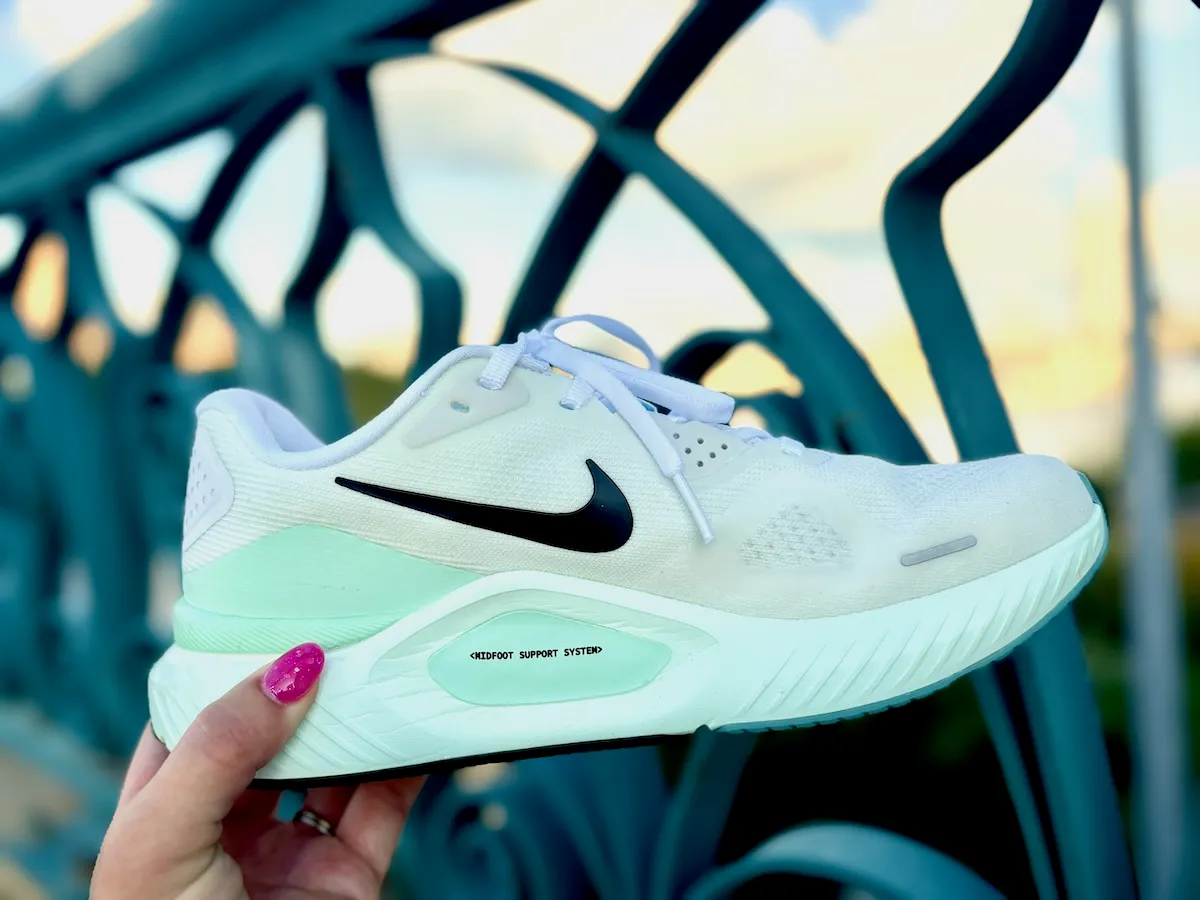 In terms of support, Nike has shifted away from rigid posts and instead uses its Midfoot Support System, which wraps the foot in two areas; the lateral rear heel and the medial midfoot. This delivers guidance and stability without ever feeling overbearing.
In terms of support, Nike has shifted away from rigid posts and instead uses its Midfoot Support System, which wraps the foot in two areas; the lateral rear heel and the medial midfoot. This delivers guidance and stability without ever feeling overbearing.
And you’ll appreciate that support, because the Structure 26 carries its highest stack height to date—38 mm in the heel with a 10mm drop.
- Weight: 11.3 oz Men’s, 9.2 oz Women’s
- Stack Height: 38mm
- Heel Drop: 10 mm
- Available in 6 Colors
- Available in wide
- Available on nike.com for $145
- Checkout our full review of the Nike Structure 26 >>
👉 HOKA Arahi 8
Softer and more flexible than your usual stability shoe, the Hoka Arahi 8 maintains a solid sense of balance throughout the shoe while allowing for a smooth and comfortable ride.
It’s not the fastest shoe, but if you’re putting on the miles in training or heading out for a long run, this will be a great shoe to grab for.
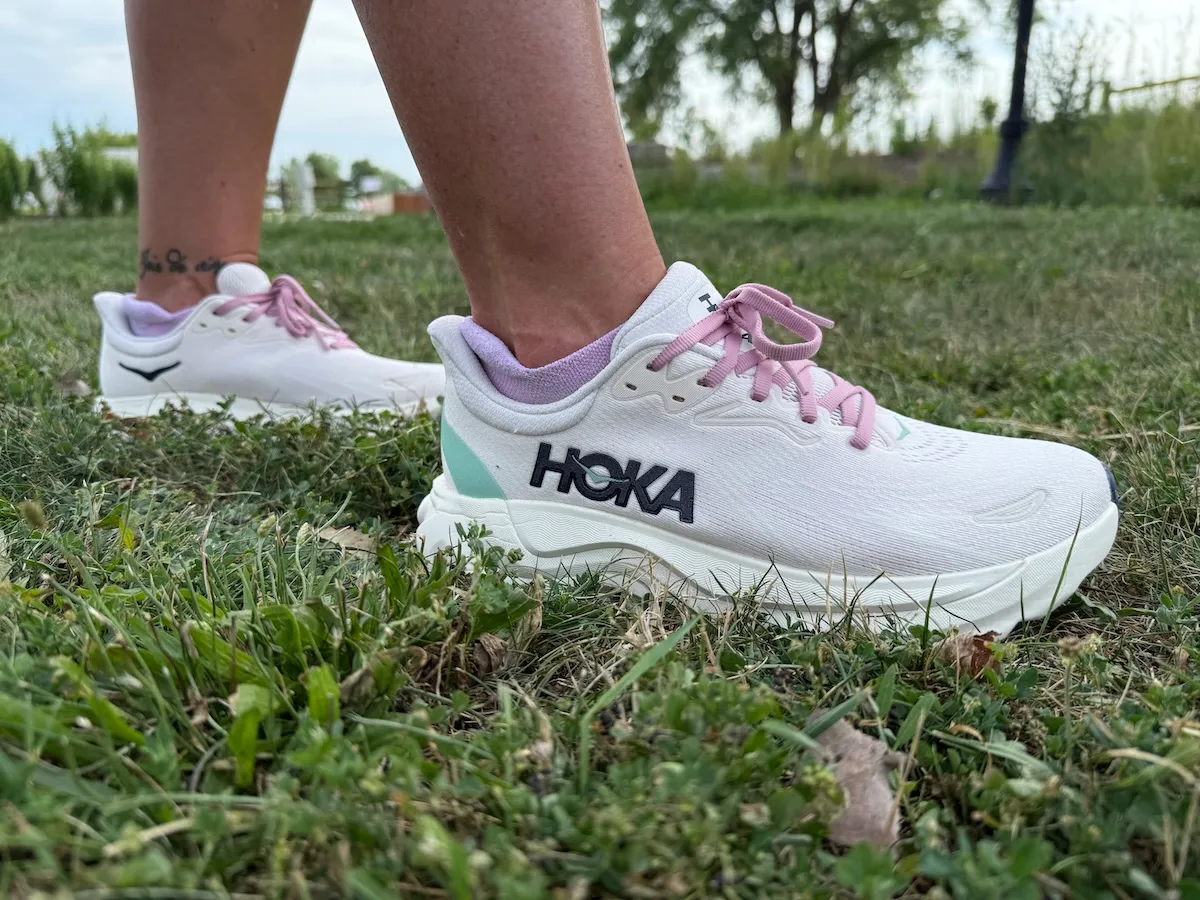
This shoe is great for easy and long training runs, especially with extra space in the toebox.
Even with an additional 3mm of foam from previous models this shoe felt light and had a little bounce to it— if you’re someone who needs a lot of support and prefers a more rigid shoe, this might not be the choice for you.
- Weight: 9.8 oz Men’s, 7.7 oz Women’s
- Stack Height: 39 mm
- Heel Drop: 8 mm
- Available in 6 colors
- Available in wide and extra wide
- Available on hoka.com for $150.00
- Check out our full review of the Hoka Arahi 8 here >>
Neutral Running Shoe
Picking between these two is tough. Both are a moderate cushion and shoes that easily can be used for speed to longer runs. If I wanted just slightly softer, I’d go with the Mach.
👉Nike Pegasus 41
The Nike Pegasus has all the bells and whistles that a runner could ask for: just the right amount of cushion in midsole for maximum comfort, durable rubber outsole to withstand, and a breathable mesh upper to keep your feet feeling fresh and dry.
But let’s get real for a second. The Nike Pegasus isn’t just a pretty shoe. It’s got substance too, with a firm heel counter that keeps your foot locked in place and a molded foam insole that provides extra support for those long runs.
This is a good option for your easy weekday runs or for the support of a marathon training run.
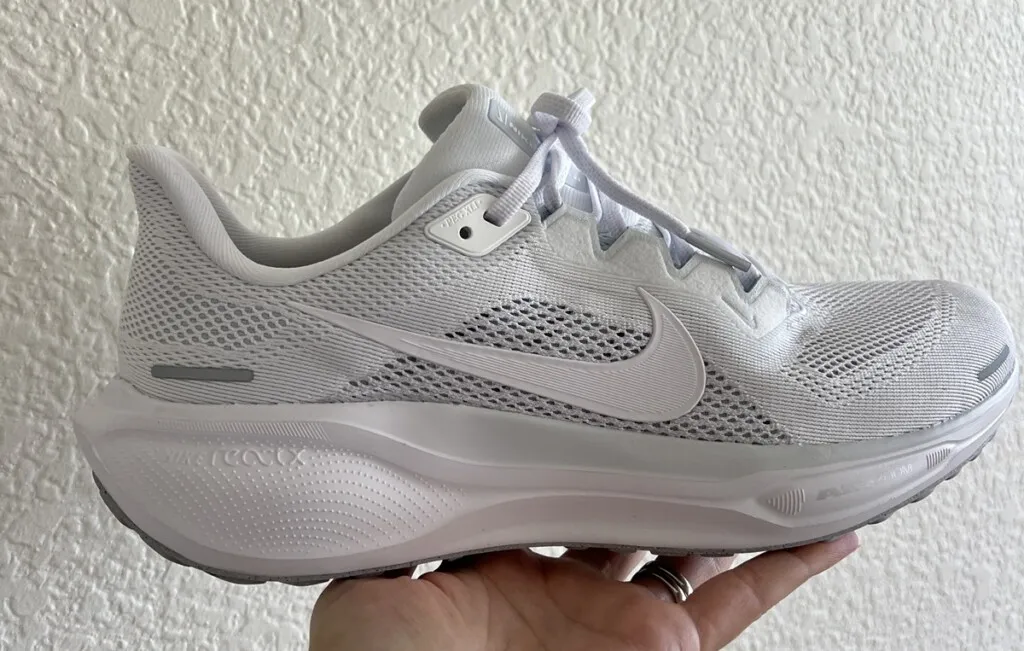
This is definitely a shoe that I like for those weekday training runs. Not over built, just enough cushion and a little roomier than other Nike’s.
- Heel drop: 10mm
- Weight: 10.4 oz men’s, 8.6 oz women’s
- Find it here on Nike.com for $140, so you can enjoy their 30 day trial policy!
- Read my detailed review of the Nike Pegasus 41
👉Hoka Mach 6
I know some are surprised not to see the Clifton here, but I really think the Mach is just a better shoe for so many.
When you’re ready to turn on the speed, the Mach is your HOKA of choice. It’s not a carbon plate shoe, instead it’s a super lightweight running shoe designed to spring off the ground and help you find that quick turnover.
Why it’s on the list though is it’s not just a speed shoe, it’s very much a great daily trainer. The Mach features a lightweight foam midsole that provides a quick, lively feel, while the meta-rocker design helps to encourage a more natural gait.
The Mach features a lightweight foam midsole that provides a quick, lively feel, while the meta-rocker design helps to encourage a more natural gait.
- Heel Drop: 5 mm drop
- Weight: 6.8 oz women’s, 8.2 oz men’s
- Available in 9 colors
- Available in Wide in some colors
- $140
- Read my full HOKA Mach 6 review
- See all HOKA Mach models (also includes a Ironman version)
Cushioned Running Shoe
👉Nike Vomero 18
My friends this shoe is a jaw dropper. A massive update to their previous models and we LOVE IT. This is max cushion done in a way that just feels good mile after mile and honestly while the weight listed is high, we just didn’t notice it at all while running.
At a whopping 46mm heel stack height, you will absolutely know this is a cushioned running shoe. It doesn’t feel unstable, but also not as stable as some shoes with a wider midsole flare. 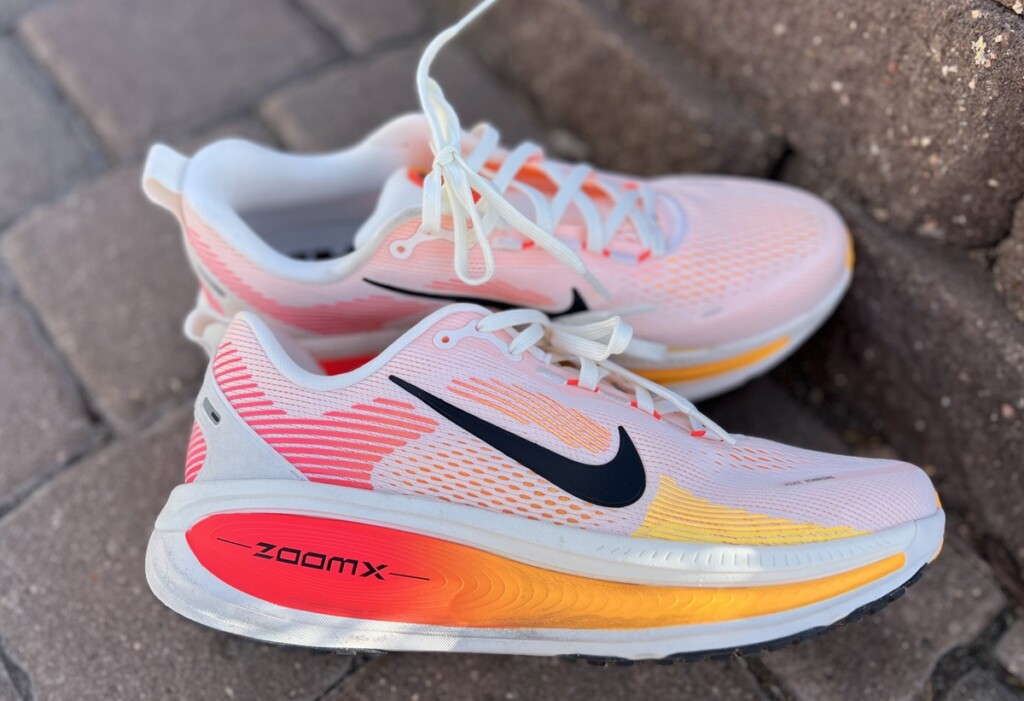 This is going to be a cushioned shoe for all those long easy runs and for many runners to cover the full 26.2 distance comfortably.
This is going to be a cushioned shoe for all those long easy runs and for many runners to cover the full 26.2 distance comfortably.
Again, watch to see a Premium and a Plus version of this shoe coming as they streamline their categories.
- Heel Drop: 10mm
- Weight: 9.3 oz women’s, 11.4 oz men’s
- Shop the Nike Vomero for $150
- Read our full Nike Vomero 18 review
👉Hoka Skyflow
I am super excited to be updating this article with the Skyflow to replace the Bondi. While it was a good shoe, it was so plush that I found some runners ended up with back pain because they simply sink in to the shoe and lose good form.
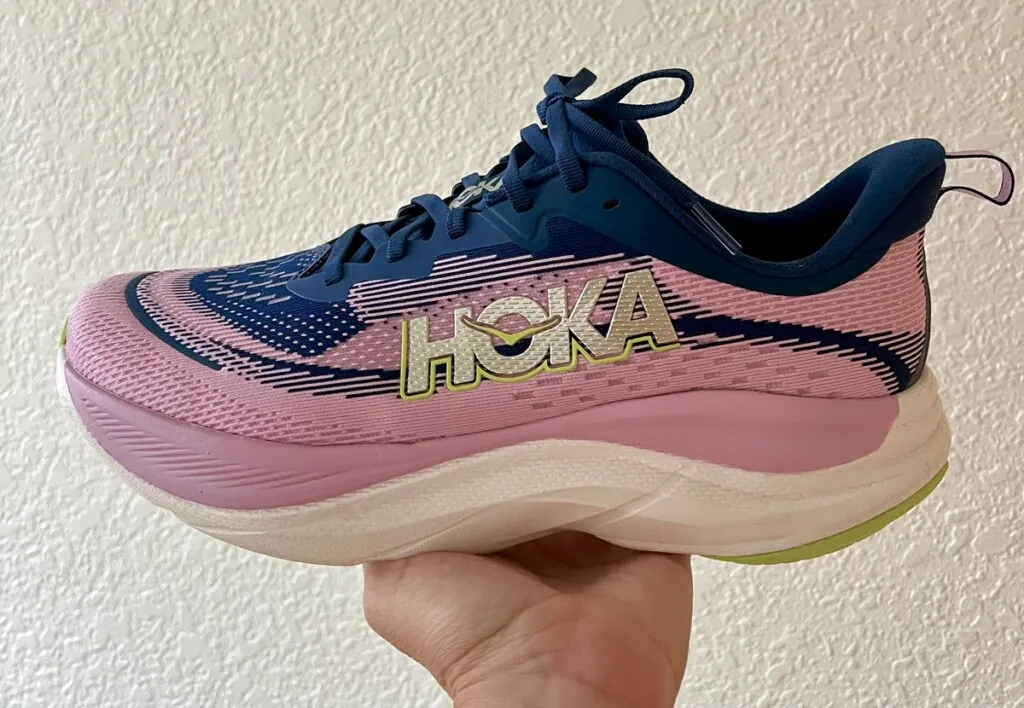
The Skyflow will not have that issue and you’ll be getting an even better quality foam! In fact, you’re getting the same supercritical foam that we see in top end shoes. That means cushion with a little bounce.
Due to the weight, this is definitely not a fast tempo run kind of shoe and yet with the same cushion as the Mach, it’s 100% a shoe that I could a lot of runners using on race day for the half or marathon. It just feels good underfoot and has enough room in the shoe for your foot to swell a bit on those long runs.
- Heel drop: 5 mm (41 mm stack on men’s)
- Weight: 8.6 oz women’s, 10 oz men’s
- Available in wide
- Available in the most sizes and colors on HOKA.com for $160
- Read my review of the Hoka Skyflow>>
Carbon Fiber Plate Shoes
Are they cool new technology, yes. Do they last as long as your other shoes, nope.
So if you want to test these out use them for speed work and then race day!
👉Vaporfly 4
Perhaps the most surprising thing about these shoes is how good they feel right out of the box. They’re super light and responsive, and for us, made race day seem too far away.
If you’re running your next even with a personal record in mind, these could give you the extra pop that you need to keep pushing across the finish line.
The ZoomX foam is a favorite for a reason, and their improved Flyplate has a more aggressive curve designed to maximize leverage from your foot and ankle. It’s a stable platform, especially through the toe-off.
On the downside, no updates have been made to the outsole, so it seems like durability remains a bit of a concern.
This is a light, stylish, fast shoe, but not one meant for those with wide feet or other support concerns.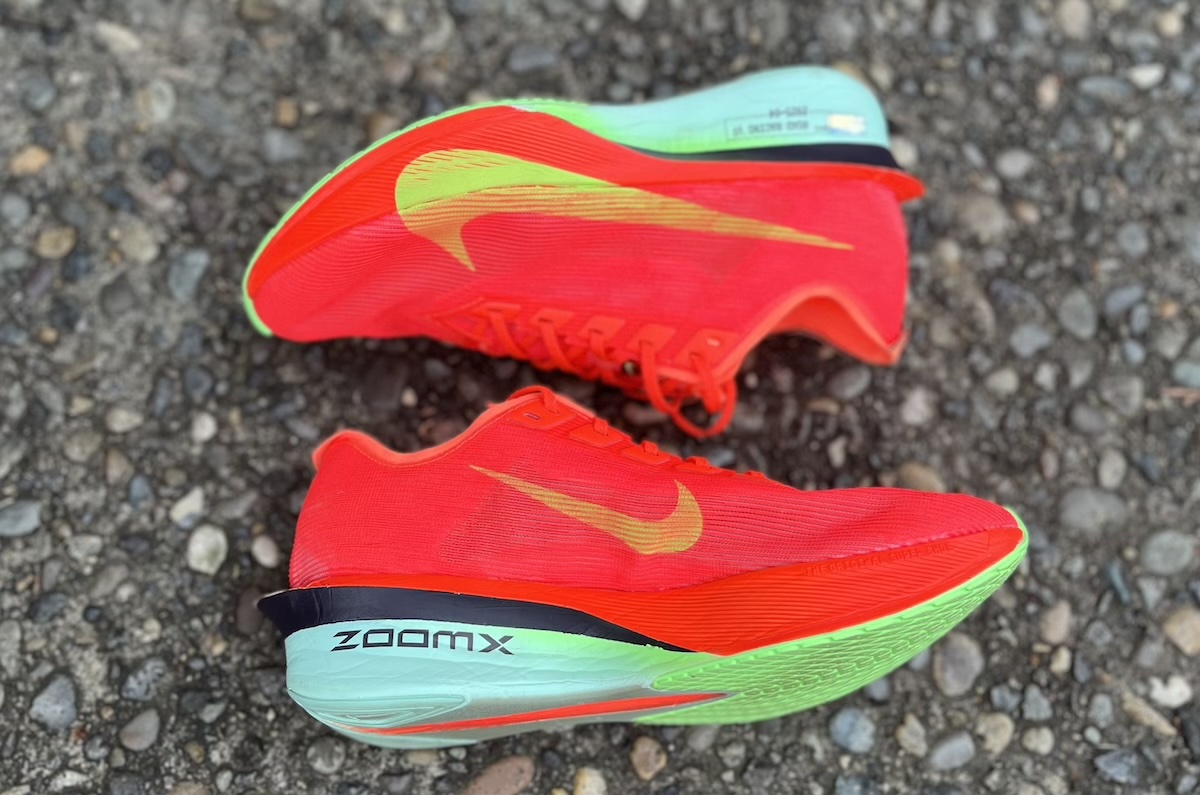
- Weight: 6.7 oz Men’s, 5.3 oz Women’s (Unisex sizing)
- Heel Drop: 6 mm
- Available in 3 colors
- Not available in wide
- Available on Nike.com for $260
- Check out our full review of the Nike Vaporfly 4 here >>
And more importantly a comparison of the Nike Alphafly vs Vaporfly. Which is the right race shoe for you?
👉Hoka Cielo X 1 2.0
We thought the first model was a fun ride, but the second model feels like they have dialed in lot of features to really make this a front of the pack shoe.
This is definitely a shoe that can take you sub 1:30:00 in the half marathon or under 3:00:00 for a marathon.
With explosive PEBA foam, an aggressive forefoot rocker, and a winged carbon-fiber plate, it’s designed to keep you rolling forward and feeling fast from start to finish.
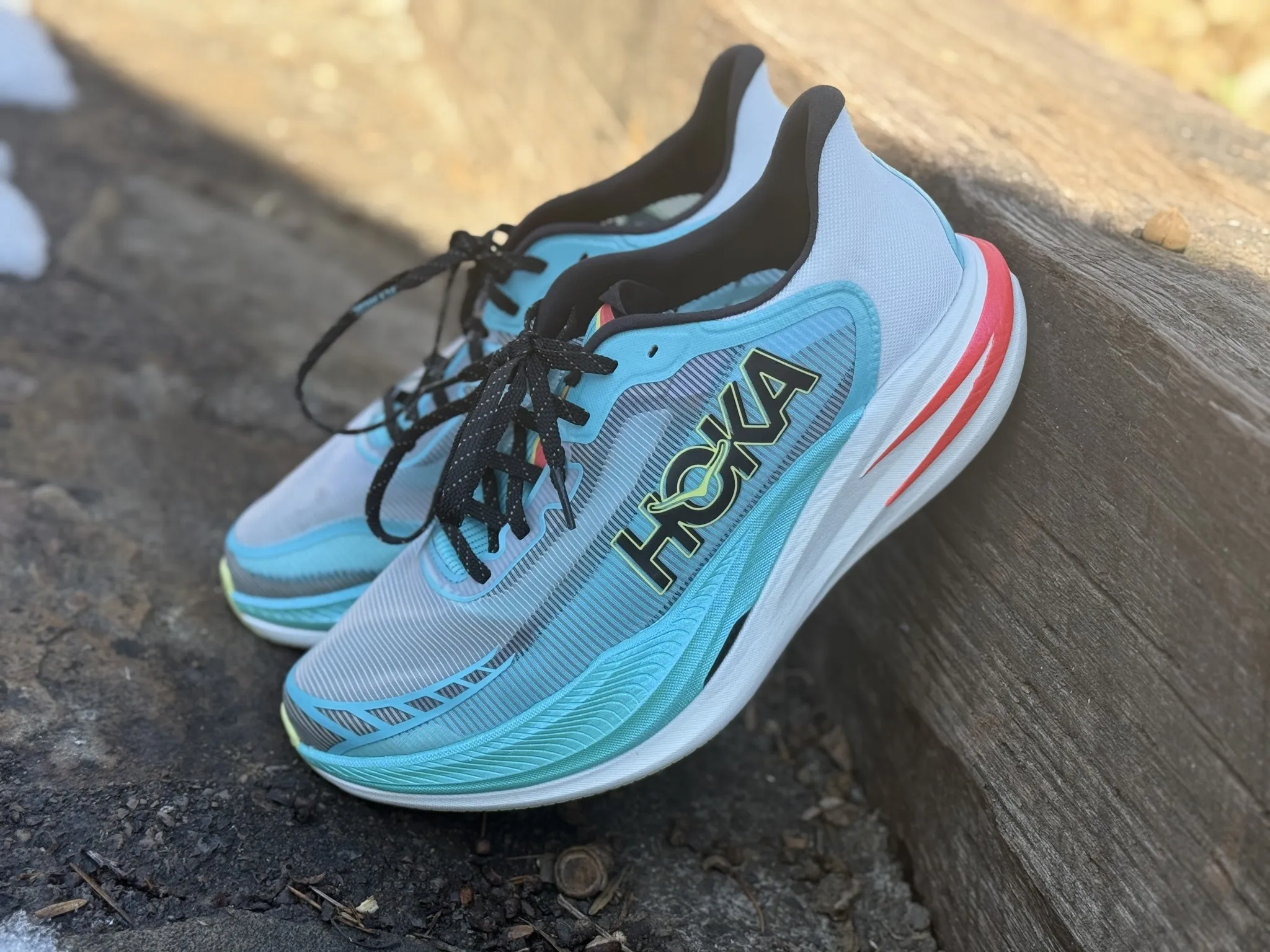
The only drawback to this model is a loss in stability. So if that’s something you need or concerns you over long runs, it might not be the winning option.
-
- Good for the front of the pack racers, 3 hour marathoners
- Weight: 6.8 oz Women’s, 8.1 oz Men’s
- Heel Drop: 7 mm
- Colors: Available in 1 colorway
- Not available in wide
- Available on Hoka.com for $275
- See the complete HOKA Cielo X1 2.0 review
Trail Running Shoes
Both brands also have a good number of trail running shoes and are well loved among the ultrarunning crowd. There’s such a variety this could be it’s own article, so I’m picking two of their most loved options.
👉Wildhorse 10
Nike is really making a push into the trail shoe space with their updated Wildhorse, which is built well for mid- to long-distance trail runs and technical terratin.
The upper has been redesigned with engineered mesh that’s breathable and an ankle collar that boasts improved debris protection.
The outsole is also a step up, and the ReactX foam midsole gives the whole shoe a responsive feel. It also reduces impact fatigue when your runs stretch longer.
The Trail ATC outsole performs well on dry dirt, gravel, and slick patches. The lug pattern offers a solid grip, but probably wouldn’t be the best choice when tackling mud or looser terrain.
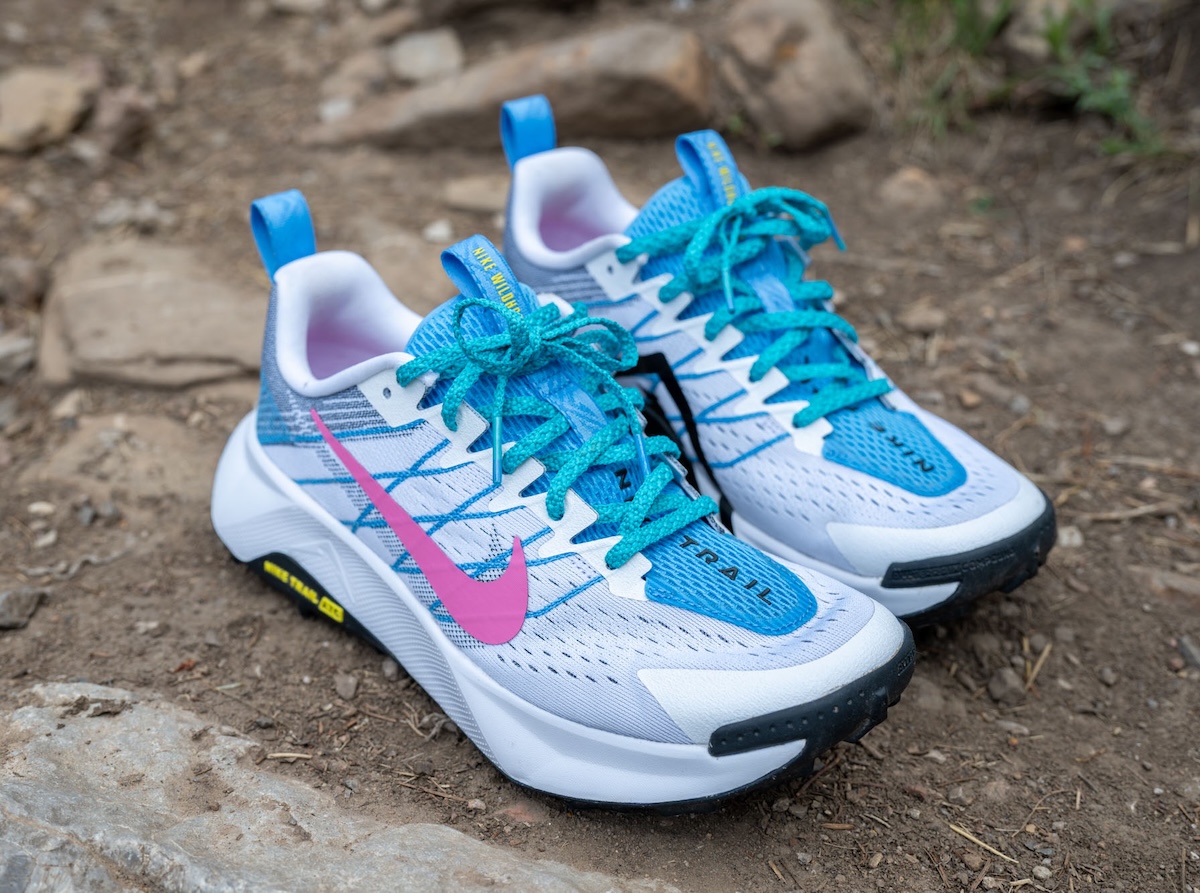
- Weight: 8.6 oz Women’s, 11 oz Men’s
- Heel Drop: 9.5mm
- Available in 3 colors
- Not available in wide
- Available on Nike.com for $165
- Check out our full review of the Nike Wildhorse 10 here >>
👉HOKA Speedgoat 6
I like to say the Speedgoat is the Clifton with extra traction. While that’s not 100% true, it’s pretty close! So if you love the feel of their classic neutral trainer then the Speedgoat is going to be a winner for you as well.
It’s absolutely become one of my go to trail running shoes.
You might think with the stack height that it makes trails harder and it HOKA is one of the preferred shoes for ultramarathon runners. Which I believe is due to the good combination of cushion and stability.

The Speedgoat 6 features a durable design that provides a comfortable and stable ride on any terrain. The shoe also features a breathable upper, which helps to keep the feet cool and dry during runs.
I’ve loved multiple versions of this shoe. The newest model happens to be the lightest!
- Heel drop: 5 mm
- Weight: 8.2 oz women’s, 9.8 oz men’s
- Available in 11 colors
- Available in Wide in some colors
- $155
- See all HOKA Speedgoat models (also includes a waterproof option)
- See my detailed Hoka Speedgoat Review >>
More About Nike Running
Is there anyone who doesn’t know the story of Nike yet?? The brand actually started in 1964 as Blue Ribbon Sports and didn’t take on the name of Nike the Greek Goddess until 1971.
If you haven’t read Shoe Dog by Phil Knight, it’s a wonderful book that gives you so much insight to the building of a company and a brand.
I fully understand not everyone loves Nike due to many of the practices we’ve seen with their athletes. I’m just here to provide details about the gear, you make those judgements.

In 1972, the Nike Waffle Racer was handed out at the Olympics and things really started to take off. One of these original pairs of shoes recently sold for almost $500,000!
From there they have continued to inovate and consistently produce new models of shoes for a variety of sports.
Nike has also dominated the marketing game.
Nike vs HOKA ONE ONE Feature Comparison
Both brands have been around for a while and are leaders in running shoe design (though Nike has a much longer history!). They both offer various technologies to aid with comfort, support, stability, and cushion. Where they differ most are in the fit and fashion.
The following breaks down each shoe based on the components buyers need to consider when purchasing a running shoe.
It’s gonna get a little TECHY…so you can just skip on down to the specific model comparison if you want, but personally if I’m shelling out $150 for shoes, I kinda want to know why.
Durability
The lifespan of shoes from both companies is fairly comparable.
- Nike recommends swapping out for new shoes every 300 to 500 miles. Unless you’re looking at the top end Vapor Fly which is more like 200 miles.
- HOKA is often reported to last longer. I don’t know if this is more trail runners and thus less hard surfaces which extends the life of the shoe or simply their maximal design.
Determining when to replace running shoes, of course, all depends on your gait, weight, and whether you run mostly on trail or road.
Fit
Nike running shoes are often reported to run small.
HOKA shoes run true to size from my testing. Some models are definitely a little more narrow than others, as with most brands. In fact, they have been working on increasing the toebox in newer models.
They also have a shoe finder quiz to help you get in to the right model.
👉Checkout this guide on How to Lace Running Shoes, you’ll be amazed at how you can make most shoes fit better!
Cushioning
Nike started putting air in their shoes back in 1977 to improve cushioning.
“Nike Air technology consists of pressurized air inside a tough yet flexible bag and provides more spring without compromising the structure.”
And since the 90’s they’ve been recycling waste material from production in to new shoes. They continue to look at this sustainability in developing new shoes.
Currently the React Foam is their big winner. It’s truly a great soft and light cushion.

HOKA likes to say they provide marshmallow softness. More technically PROFLY.
I’m going to admit that I was really skeptical of HOKA at the start because I assumed all that cushion would make it heavy. It turned out I was wrong and instead have been running in them since of their very first shoes.
- They have 3 levels of cushion, which is important because plush isn’t what you want on all runs
- Cushion that provides both a good landing and plenty of stability for push off
- Hubble Heel – their newest shoes with a longer heel which is supposed to improve heel to toe transition

Stability
Nike does say their stability shoes are slightly wider and also designed with a curve that will help with heel to toe transitions. But as noted that is specifically in the stability shoes.
HOKA was designed entirely with stability in mind.
It was a core foundation of their shoes because it allows runners to move quicker with less risk of injury. This is why they created a wide stable platform.
In fact, they call their heel system the “bucket seat”, like the seat of a race car. It cushions the heel and foot without posts or guide rails — this means the midsole remains more cushioned.

Overview of heel to toe drop and type of cushion in most shoe brands.
Affordability
The prices between the two brands are fairly comparable.
- Nike prices range between $120 to $180
- HOKA’s start at a slightly higher price at $120 to $250
The most popular models for Nike are around $150 and for HOKA also around $150. Specialty items with more features (like carbon plates) will increase price.
You’ll notice that every brand offers a range and this is indeed due to a difference in technology and where they sell the shoe. They know that the big box store can sell the shoe with less in it, while the local running store needs to be best for dedicated runners.
More about HOKA ONE ONE
Let’s start with how do you pronounce Hoka One One? “Ho-Kah O-nay O-nay” which is a Māori phrase that means “to fly over the earth.”
But they’re kind of like Madonna and just need one name: Hoka.
Founded by two mountain trail runners in the Swiss Alps, Nicolas Mermoud and Jean-Luc Diard, former Salomon employees, had an epiphany during their training that lead to the foundation of a new shoe and new company in 2009.
This makes them a mere baby in the world of running shoes, as many of the brands from Brooks to ASICS have been around 100+ years now. Pictured here is their first prototype.
At first they simply wanted a shoe that would allow them to run downhill faster and thus win!
Quickly they realized there was something more here with a smooth, super light, cushioned and stable shoe. Their maximal design took many of by surprise in a time where Zero Drop and Barefoot running were the in thing.
In 202o, the company was purchased by Deckers (owners of UGG and Teva). Hopefully that just means more marketing to keep the shoes going and not a change to what their doing right.
Your gait and feet will likely change over time and you may need to change shoes.
This is also why I recommend rotating through several pairs of shoes at once.
And remember, just because these are two of the most well known brands on the market, there are still plenty of other shoe brands to select from if neither Nike nor HOKA has the right shoe for you.
Keep in mind that shoe design can change, even with the same model, so always assess how the shoe fits every time you replace a pair.
For more help selecting the right shoe for you, don’t worry, I’ve got you:
- Nike Vs New Balance running shoes
- Nike Trail Running Shoes Reviewed
- Best Trail Running Shoes
- Best Long Distance Running Shoes
- Saucony vs Brooks
Other ways to connect with Amanda
Instagram Daily Fun: RunToTheFinish
Facebook Community Chatter: RunToTheFinish
Sign Up to Receive a Weekly Newsletter with Top Running Tips and Laughs



 On Cloud vs Hoka Shoes: How to Choose (Side By Side Comparisons)
On Cloud vs Hoka Shoes: How to Choose (Side By Side Comparisons)
Thank you! Very helpful article. I have worn and appreciated Nike for years – starting with Structure Triax before zoom – around 2001-ish. But as they keep changing it, they no longer are comfortable for me. I just wear them daily, including for taking real estate clients out looking at houses :) ) due to arthritis needs. Do you know which of the Hoka is similar to the older Structure Triax line – at least 5 years back (when Nike started to be less comfortable)? Thank you :)